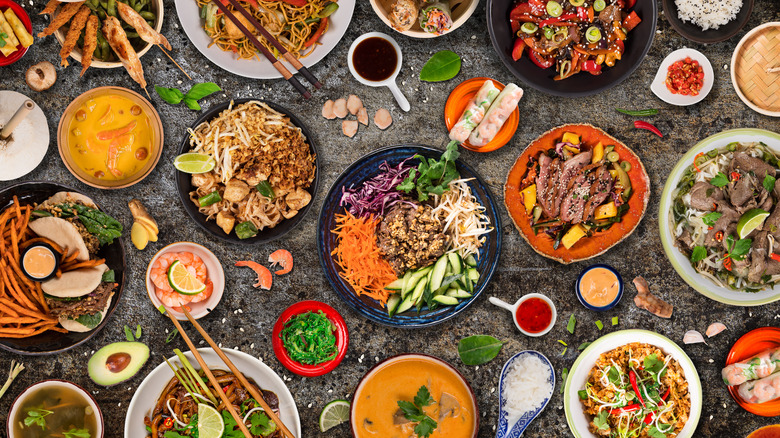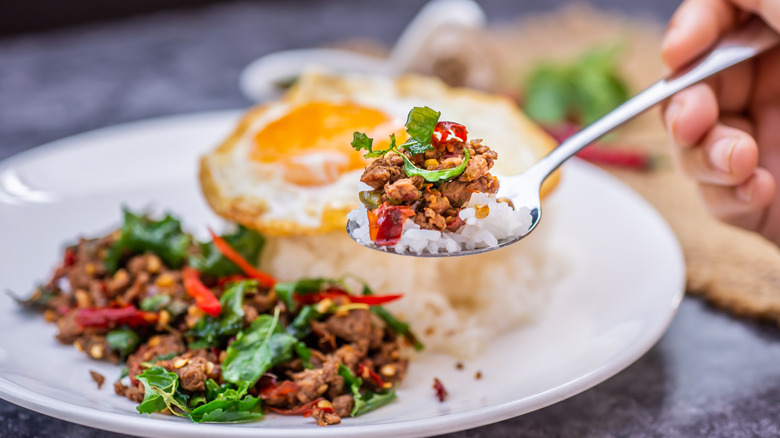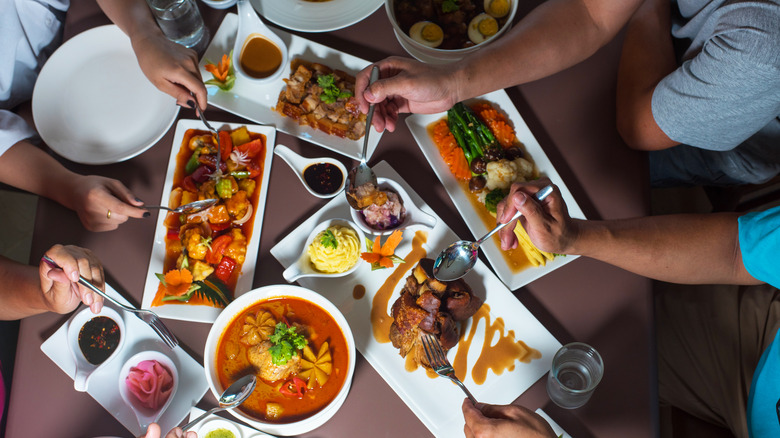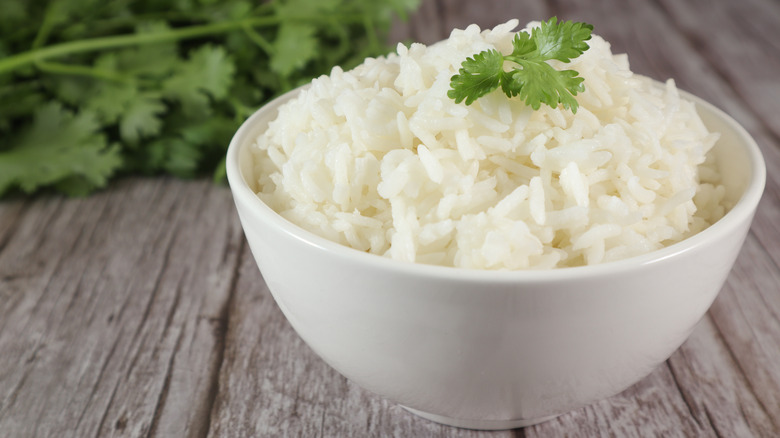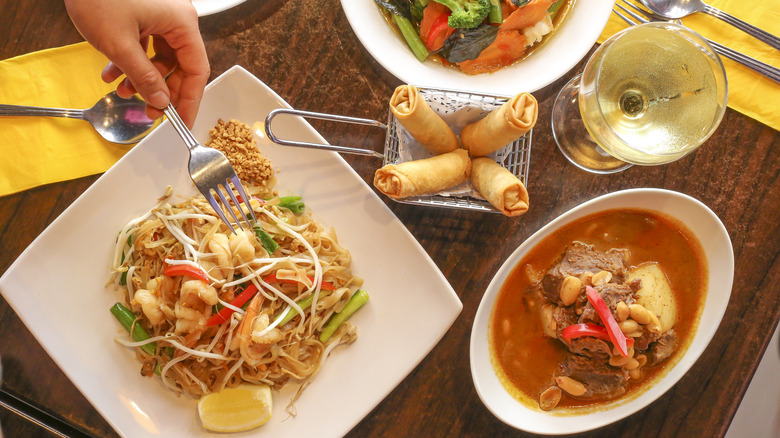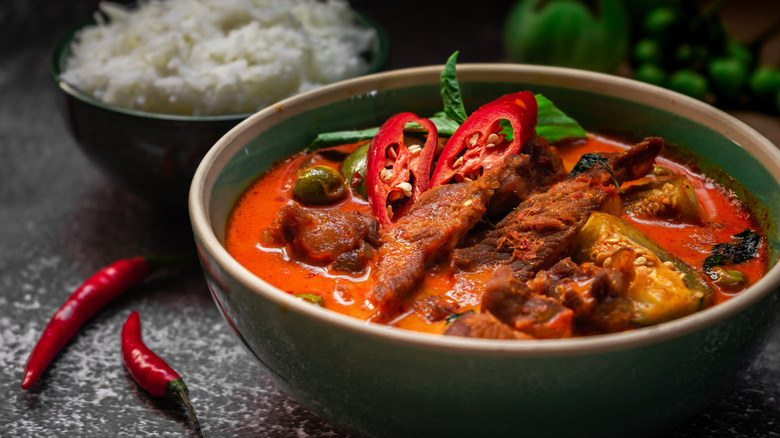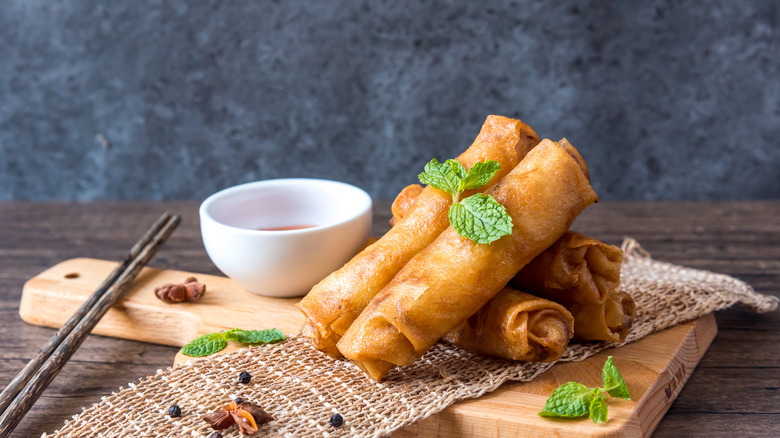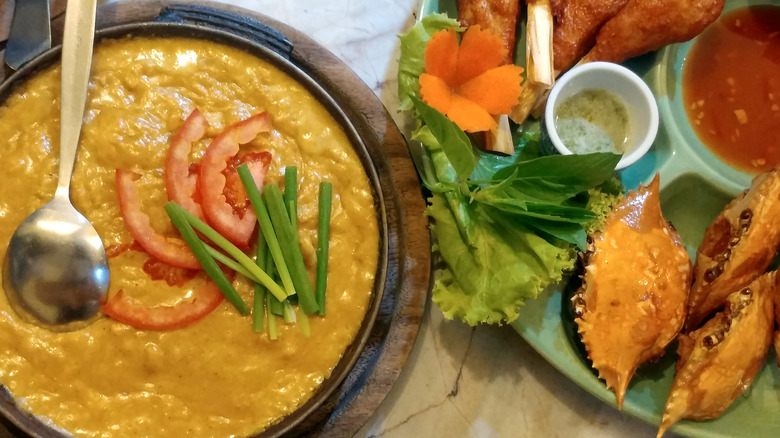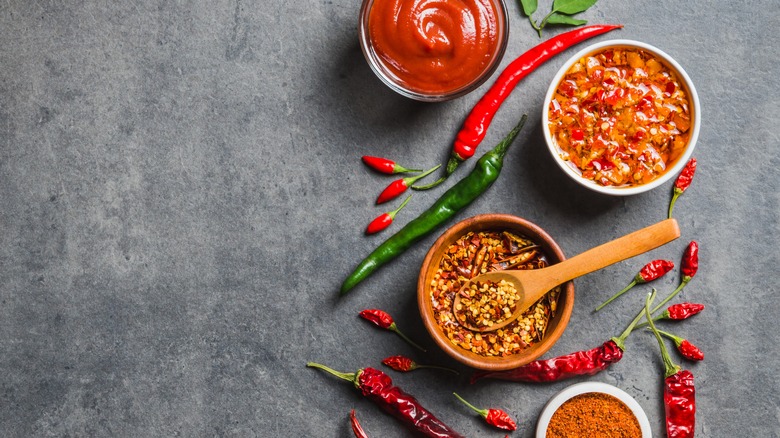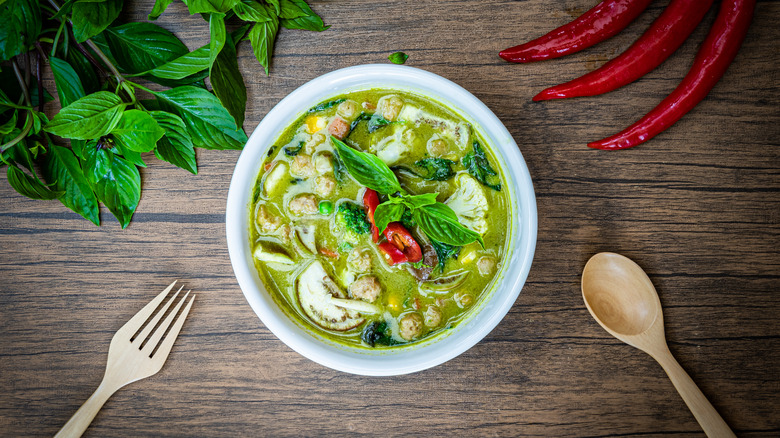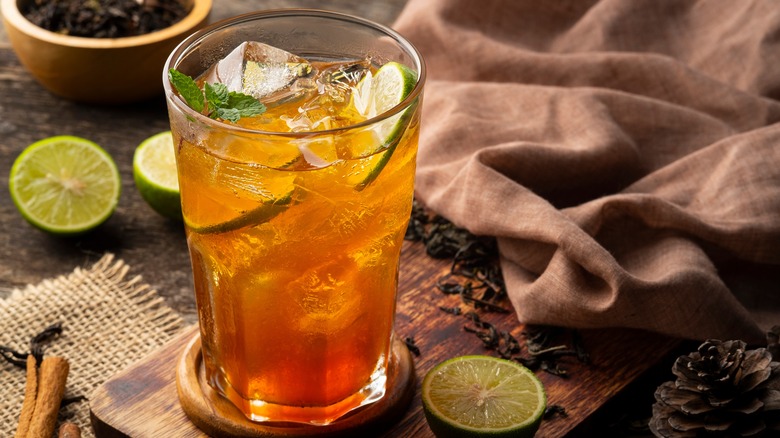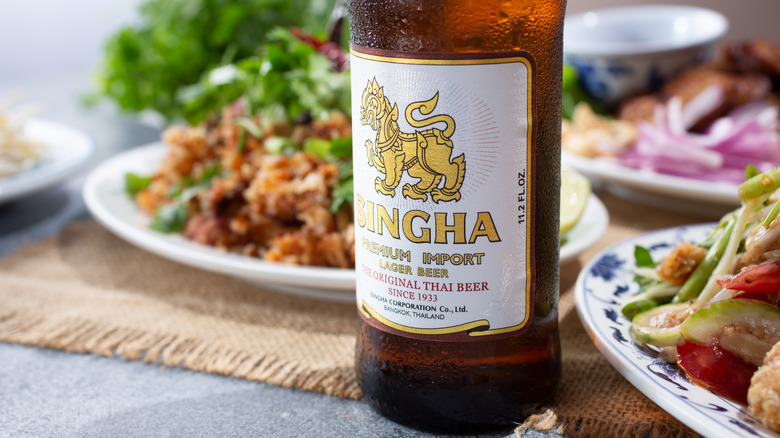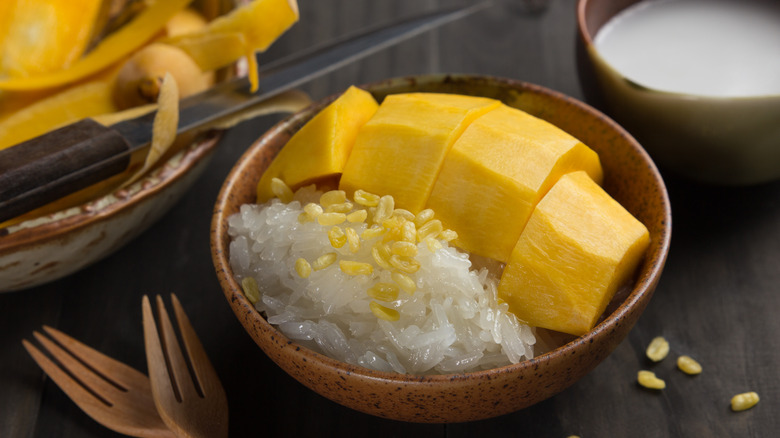Mistakes Everyone Makes When Ordering Thai Food
Thai food is popular with food enthusiasts around the globe for its unique blend of flavors, textures, and aromas. Due to the country's geography, history, and cultural influences, Thai cuisine is also extremely varied. For example, the gastronomic scene in northern Thailand is heavily influenced by China and Myanmar, making it somewhat milder than the spicier southern dishes. Meanwhile, the cuisine in the southwestern part of the country has a lot in common with Malay and Javan epicurean creations, which both utilize a lot of coconut milk.
From spicy curries to refreshing salads, there's little doubt that Thai food makes for a delicious and satisfying culinary experience. And if you have a little knowledge of the cuisine and the country's dining etiquette, ordering dishes at a Thai restaurant can be an exciting adventure in itself. On the flip side, if you're unfamiliar with Thai cuisine and its protocol, the experience can lead to ordering dishes that are overly spicy, underseasoned, or generally not to your liking.
Whether you're enjoying Thai cuisine at a restaurant in the U.S. or in the Land of Smiles, the correct dining etiquette can go a long way to enhancing your experience. Keep reading to find out more about the most common mistakes made when ordering Thai food and how to avoid them.
Asking for the wrong utensils
The assumption that all Asian food should be eaten with chopsticks couldn't be further from the truth. While servers generally won't question your choice of utensils, asking for chopsticks while ordering Thai fare is technically considered a mistake. Perhaps one Quora user sums this up best, saying, "Thai restaurants in the U.S.A. are probably used to people asking for chopsticks (most customers haven't been to Thailand, so they may think chopsticks are the main eating utensils there), so it wouldn't be rude."
While Thai people usually use chopsticks and a spoon to eat Chinese-style noodle soups, you are unlikely to see them using chopsticks with any other dishes. Instead, they use a fork to push food onto a table spoon and use the spoon to bring it to their mouths. The spoon is usually held in the right hand and the fork in the left. Since most ingredients served in Thai cuisine are either soft or bite size, knives are generally only used in the kitchen. If necessary, the spoon is used to divide food on the plate into smaller portions.
The custom of eating food with a fork and a spoon in Thailand dates back to the late 18th century when it became accepted among royalty and the Siamese elite. Prior to this, food in the country was eaten by hand, or more specifically, the right hand. Today, the only Thai dish that's still eaten with the hands is sticky rice.
Not ordering dishes to share
In Western culture, we are accustomed to ordering individual dishes. This, however, isn't the norm in many other countries, including Thailand, where food is always shared among a group of people. In other words, no dish belongs to one specific person. This communal dining experience is ideal because it gives the entire group an opportunity to sample a wide range of dishes. Sharing food is also a great way of spurring conversations and making connections with others.
Traditionally, the entire order is placed by one person at a table, and this person is typically most senior person in the group or the host paying the bill. Of course, all table companions are free to suggest which dishes they would like to try. Generally, the larger the dining party, the more dishes that are ordered to be enjoyed by the group. Once ordered, each menu selection will arrive at the table with a serving spoon. It's important to use this utensil, rather than your own spoon and fork, to transfer a little bit of each dish to your plate or bowl.
Forgetting to order rice for the table
According to a 2022 Research and Markets report, more than 90% of the global rice production and consumption takes place in the Asia-Pacific region. In fact, Thailand is the second biggest exporter of rice in the world, after India, as noted by Statista. As such, it's not surprising that the starchy grain is a staple of Thai cuisine, commonly eaten with curries, soups, and other dishes. Notably, the Thai expression for "to eat" is gin kao, which literally means "eat rice." As so eloquently put by Pailin Chongchitnant in SF Gate, rice is considered "the canvas on which to paint each bite" in the gastronomic culture of Thailand.
While rice is an essential component of a Thai feast, it can arrive at your table either in a large family-style bowl or molded on each plate. Some dishes, such as pad grapao, kao pad, and prik Thai, already come with rice so you wouldn't have to order it separately. If in doubt, it's best to ask the server. Most Thai restaurants serve jasmine rice — which is a long-grained white or brown rice — as an accompaniment to dishes.
Failing to balance different flavors and textures
While we all have our favorite Thai dishes — pad Thai (stir-fried noodles) and tom yum (zesty soup) come to mind here — it's important not to shy away from being adventurous when ordering food. After all, how are you going to discover new dishes if you never venture outside your comfort zone? And since Thai meals are usually shared, ordering a wide variety of dishes can take your dining experience to the next level. After all, who wants to eat four different noodle dishes when they can try some noodles, a stir-fry, a curry, and a soup.
Thai cuisine features four main flavors — spicy, sour, salty, and sweet — as well as a variety of textures. Ordering a number of different dishes can balance these flavors and textures to create a meal that's both harmonious and satisfying. As noted by Kitchen United, a Thai feast typically includes a wet dish, such as a curry or a soup, a dry dish like a stir-fry, a spicy dish, and a yum — a salad dish with a dressing made from fish sauce, lime juice, sugar, and chilies.
Not specifying how spicy you like your dishes
Thai food is well-known for its spices. And while not all of them are fiery, others use red and green chilies to add heat to the dish. If you like your food mild, pad Thai and yellow curry are great choices. On the other hand, dishes such as som tam (spicy papaya salad) are likely to leave you with a tingling tongue.
If you're not sure about the spiciness of a certain dish, don't be afraid to ask the server. In most Thai restaurants you can actually request specific heat levels to enjoy your food exactly the way you like it. However, as Holiday Home Times advises, it's better to err on the side of caution since Thai "medium spicy" often equates to "extremely spicy" for most Americans — particularly if you are eating at a restaurant in Thailand.
Not everybody gets the spice level right every time. Last year, a Thai restaurant in England garnered attention for the way it dealt with customers who ordered overly spicy dishes. Tired of refund requests, the establishment posted a notice in its window that read, "We will no longer issue refunds when you order your food spicy and can't handle it," as noted by one Twitter user. If you do happen to accidentally get more spice than you can handle, Tasty Thais recommends eating bread or drinking dairy to soak up the oil that triggers the pain receptors in your taste buds.
Opting for too many unhealthy dishes
Thai food is relatively healthy — especially if you compare it to Western-style fast food. For starters, most Thai dishes come with veggies, providing a nutritious component of the meal. Even beef, chicken, or seafood dishes are likely to incorporate vegetables such as carrots, peas, and bean sprouts. Many Thai dishes are also infused with spices and herbs such as turmeric, lemongrass, and garlic, which are believed to have numerous health benefits. In addition, most Thai restaurants prepare their food with fresh, rather than frozen, ingredients
Nevertheless, there's no escaping the fact that Thai food can be as healthy or unhealthy as your food choices. To maintain a healthy diet, try to minimize the number of fried and deep-fried dishes such as fried rice or spring rolls. While they might taste great, their high oil content can be a drain on your health and arteries over time. Some dishes such as curries can also be calorie heavy since they tend to contain between one and two cups of coconut milk. The good news is that even if you order a couple of less healthy options for the table, you can balance them out by ordering a few lighter dishes.
Expecting appetizers, soups, and mains to come at different times
A traditional Western-style meal begins with starters or small portions of food designed to stimulate the appetite. The appetizers are usually followed by soup, which is served to cleanse the palate. The whole meal revolves around the main course, which is often the most substantial part of the dining experience. Finally, the proceedings are completed with some type of dessert.
According to Holiday Home Times, a typical formal Thai dinner includes rice, a soup or a curry, a few chicken and pork stir-fried dishes, a fish, a zesty salad, a noodle dish, and a dessert. Other than the dessert, which comes separately at the end of the meal, all the dishes are served and eaten at the same time. As such, most Thai restaurants don't follow the multi-course approach — don't be surprised if all your dishes arrive at the table all at once or in random order. This can be the case even at restaurants that list their menu options under different categories such as starters, soups, and mains.
Not asking for condiments
While in many Western-style restaurants asking the server for condiments might be taken as commentary on the quality of the dishes, this isn't the case in Thai culture. Thai people often modify dishes with condiments to harmonize the sweetness, sourness, saltiness, and spiciness of their food. In fact, some Thai restaurants even have a basket of condiments at each table to let patrons season their own food — however, this isn't the case for most fine dining establishments.
Some of the most commonly found condiments at Thai restaurants include dried chili flakes, sugar, fish sauce, and white vinegar (these are a little like the salt and pepper found in many Western-style restaurants). Some dishes also come with dipping sauces, such as nam jim gai or sweet chili sauce, and prik nam pla, a fish sauce with sliced chilies. At the end of the day, it's up to each individual to match the sauce with their food. This is commonly done by adding a few drops of the sauce to the dish or dipping the seafood or meat directly in the sauce.
Overlooking vegetarian options
Thai cuisine is known for its range of fresh ingredients, including an abundance of vegetables, fruit, and herbs. Many Thai restaurants also use tofu and other meat substitutes made from soybeans in their dishes. Whether you follow a vegetarian diet or are simply looking to explore new culinary experiences, ordering vegetarian food during your next dinner at a Thai restaurant can open up a whole new world of flavors.
Vegetarians should beware, however, because many Thai dishes that appear meat- and seafood-free at first glance may be deceiving. This is because in Thai cuisine many vegetable dishes contain ingredients such as fish sauce, oyster sauce, or meat stock (these aren't typically listed on the menu).
Luckily, it's not all bad news. As noted by CNN Travel, many Thai restaurants cook food on the spot, which allows you to let the servers know what ingredients should be omitted from the dish. This also goes for other dietary restrictions since many Thai dishes may contain gluten and peanuts. Some of the safer plant-based Thai dish choices include fresh spring rolls, vegetarian tom yum soup, and glass and noodle salads.
Not ordering Thai iced tea with your meal
Thai iced tea is a popular beverage to order with Thai food because it pairs well with the bold, spicy flavors of the cuisine. This being said, it's important to remember that not all Thai iced tea is the same. At its most basic, Thai iced tea is black tea flavored with spices such as cardamom, tamarind, and star anise. Thai iced tea may also contain sugar and condensed milk, making it a less healthy choice when it comes to quenching your thirst.
Priya Krishna from Food & Wine calls Thai iced tea a "culinary hybrid" that combines the simple concoction of tea and ice with the Western penchant for sweet flavors. Krishna explained that chefs started adding spices, sugar, and even food coloring to Thai iced tea to distinguish it from American iced lattes. Pim Techamuanvivit, the chef and proprietor of Kin Khao in San Francisco, says that nowadays the sweeter, richer version of the beverage is served in many restaurants in Thailand. "It's interesting to look at, as it was something that was perceived as very Thai in the U.S., but then the U.S. version got transferred back to Thailand, and Thai people have just adapted," she told Food & Wine. "Thai tea is the perfect example of the way that cultures end up bleeding into each other."
Missing out on Thai beer
Beer enthusiasts shouldn't leave a Thai restaurant without trying one of the country's brews. The most popular Thai beers are Chang, Singha, and Leo, with some Thai restaurants in the U.S. serving at least one of the brands. According to a 2020 report by Flanders Investment and Trade, the three brands hold about 94% of Thailand's beer market share, with Leo accounting for 53% of the sales, Chang 35%, and Singha 7%.
Short for Leopard, Leo is produced by the Boon Rawd Brewery. The beer, which entered the market in 1998, is milder and slightly sweeter in flavor than Chang and Singha. Also produced by the Boon Rawd Brewery, Singha dates back to 1934, making it the first Thai beer brand. Translating to Lion in Thai, Singha is made from different types of European hops and 100% barley malt. Chang Beer first appeared in 1995 and is produced by Thai Beverages. Translating to elephant in Thai, Chang Beer is a lager made from malt, hops, and rice.
Ignoring the dessert section
In Thailand, desserts are a key part of the country's culinary culture, and they are as diverse and delicious as the country itself. Significantly, in Thailand, different desserts are frequently eaten to give meaning to different occasions, as highlighted by Thai dessert expert ML Darunee Chakrabandhu in a Bangkok Post article. For example, khanom chan with layers signifies prosperity, while the same cake without layers is eaten at funerals.
One of the best introductory desserts to try at a Thai restaurant is mango and sticky rice. Just like its name suggests, the treat combines the sweet flavor of mango with the chewy and rich texture of sticky rice. The dish is usually served with coconut milk. Crepes are another popular Thai street-side dessert. The crepes are usually filled with a delicious creamy meringue made from egg whites and sugar. Thais are also partial to coconut ice cream, which is commonly served with toppings such as peanuts, sweet corn, and sweet syrups.
